I know that you are reading articles on line, in magazines, and perhaps watching TV specials about the tenth anniversary of the 9-11 attacks and I feel almost awkward adding to the torrent of words and images. Yet, we need them somehow, don’t we? In the review from the other day I recommended Skye Jethani’s new book With (thanks to friends who ordered it–we are grateful and hope you like it as much as I did.) Yet, somehow, although we practice the presence of God, realizing that the Risen Christ is truly with us, we are, some of us, need to know that there are others with us, too. Being in touch and sharing our stories reminds us that we are not alone. There is little doubt that many of us want to talk about where we were ten years ago, how we heard, who we fretted about and how we grieved. So, doing our part, we offer some books for your consideration. We stock some classics—national best sellers, say, like, The Looming Tower: Al-Qaeda and the Road to 9/11 by Lawrence Wright (Vintage; $15.95) which won the Pulitzer Prize. We would like to offer some less well known resource, book that we think you will enjoy knowing about. I think they would be useful this month as we reflect and commemorate this important milestone in our collective experiences.
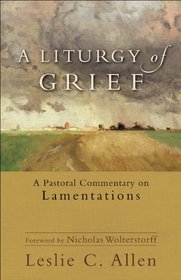 A Liturgy of Grief: A Pastoral Commentary on Lamentations Leslie C. Allen (BakerAcademic) $21.99 Even as he was becoming a senior Old Testament professor at Fuller Theological Seminary, Allen served (and continues to serve) as a hospital chaplain for over 10 years. This is the first clue that this Biblical scholar is well acquainted with grief. A scholar who does his exegesis through tears is to be trusted, I’d say. Nicholas Wolterstorff writes of this splendid new book that it “is at one and the same time an important contribution to our understanding of and dealing with grief and an important contribution to our understanding of one of the supreme pieces of literature in the Old Testament.” Other scholars of the Hebrew Bible concur (M. Daniel Carroll R. of Denver and Tremper Longman, for instance.) Are you heavy of heart? Do you do caregiving for the hurting? Do you preach or teach those who need to hear an affirmation of their need for rituals of grief? I don’t know what those churches who call their contemporary worship services “celebrations” will do this week, but this book could help.
A Liturgy of Grief: A Pastoral Commentary on Lamentations Leslie C. Allen (BakerAcademic) $21.99 Even as he was becoming a senior Old Testament professor at Fuller Theological Seminary, Allen served (and continues to serve) as a hospital chaplain for over 10 years. This is the first clue that this Biblical scholar is well acquainted with grief. A scholar who does his exegesis through tears is to be trusted, I’d say. Nicholas Wolterstorff writes of this splendid new book that it “is at one and the same time an important contribution to our understanding of and dealing with grief and an important contribution to our understanding of one of the supreme pieces of literature in the Old Testament.” Other scholars of the Hebrew Bible concur (M. Daniel Carroll R. of Denver and Tremper Longman, for instance.) Are you heavy of heart? Do you do caregiving for the hurting? Do you preach or teach those who need to hear an affirmation of their need for rituals of grief? I don’t know what those churches who call their contemporary worship services “celebrations” will do this week, but this book could help.
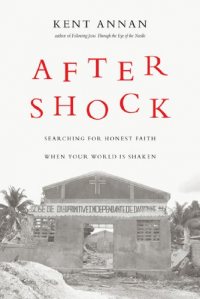 After Shock: Searching for Honest Faith When Your World Is Shaken Kent Annan (likewise/IVP) $15.00 I mentioned in my previous post a few books that might serve us well as we talk together about the floods and natural disasters that have hit so many. There was one book I considered mentioning but wanted to hold off listing it until I could commend it here. It is a very special book. While After Shock was written in the aftermath of the horrific earthquake in Haiti a year and a half ago, it could also serve as a serious reminder of what it is like to have faith shaken after any sort of rending crisis. Whether your anguish is over a neighborhood shooting or a family cancer that has rocked your world; whether you are led to doubt God’s goodness after a natural disaster like a tornado or flood or whether this week’s 9-11 recollections uncover deep anguish in your soul, this book will speak honestly to you. You see, Kent was himself a passionate missionary serving the poorest of the poor in Haiti (and he had written an excellent book about Christ’s call to serve others, one we often recommended, Following Jesus Through the Eye of the Needle: Living Fully, Loving Dangerously; likewise/IVP; $15.00.) He worked hard on that one, editing carefully, as authors will, and worked to make it interesting and compelling.) After the earthquake, Kent told me, this second book just poured out of him. There was little time to ponder, no time for re-writes. The wonderful, edgy imprint, likewise, wanted a raw and honest appraisal of how to cope when, as the subtitle suggests, the ground below your feet is rocked. If you are coping with any sort of trauma or you just wonder how in the world to make sense of a world gone awry, this book is a wonderful conversation partner and Kent will be a good companion in your pilgrimage on the way towards new hope.
After Shock: Searching for Honest Faith When Your World Is Shaken Kent Annan (likewise/IVP) $15.00 I mentioned in my previous post a few books that might serve us well as we talk together about the floods and natural disasters that have hit so many. There was one book I considered mentioning but wanted to hold off listing it until I could commend it here. It is a very special book. While After Shock was written in the aftermath of the horrific earthquake in Haiti a year and a half ago, it could also serve as a serious reminder of what it is like to have faith shaken after any sort of rending crisis. Whether your anguish is over a neighborhood shooting or a family cancer that has rocked your world; whether you are led to doubt God’s goodness after a natural disaster like a tornado or flood or whether this week’s 9-11 recollections uncover deep anguish in your soul, this book will speak honestly to you. You see, Kent was himself a passionate missionary serving the poorest of the poor in Haiti (and he had written an excellent book about Christ’s call to serve others, one we often recommended, Following Jesus Through the Eye of the Needle: Living Fully, Loving Dangerously; likewise/IVP; $15.00.) He worked hard on that one, editing carefully, as authors will, and worked to make it interesting and compelling.) After the earthquake, Kent told me, this second book just poured out of him. There was little time to ponder, no time for re-writes. The wonderful, edgy imprint, likewise, wanted a raw and honest appraisal of how to cope when, as the subtitle suggests, the ground below your feet is rocked. If you are coping with any sort of trauma or you just wonder how in the world to make sense of a world gone awry, this book is a wonderful conversation partner and Kent will be a good companion in your pilgrimage on the way towards new hope.
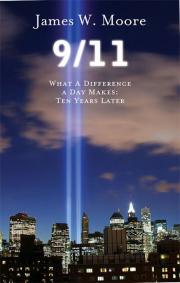 9/11: What a Difference a Day Makes: Ten Years Later James W. Moore (Abingdon) $7.50 I wanted to list this one because it is so very clear, simple, concise and inspirational. James Moore is a best-selling author of oodles of upbeat, clever books, a great storyteller and a fine United Methodist Bible teacher. This just a bit larger than pocket-sized paperback is useful for anyone who is stressed who needs to be reminded how God is with us (even in the turbulence–you have to read that chapter inspired by a great illustration.) He has a good, common-sense chapter on why religion can be a force for good and not evil, and how we can recall the stories of 9-11 to find comfort and hope. The last chapter is a pleasant reminder–or is it a plea?—that a shared experience like this can bind us together as we have shared sorrow and shared resolved. United we stand, in shared love. Nice.
9/11: What a Difference a Day Makes: Ten Years Later James W. Moore (Abingdon) $7.50 I wanted to list this one because it is so very clear, simple, concise and inspirational. James Moore is a best-selling author of oodles of upbeat, clever books, a great storyteller and a fine United Methodist Bible teacher. This just a bit larger than pocket-sized paperback is useful for anyone who is stressed who needs to be reminded how God is with us (even in the turbulence–you have to read that chapter inspired by a great illustration.) He has a good, common-sense chapter on why religion can be a force for good and not evil, and how we can recall the stories of 9-11 to find comfort and hope. The last chapter is a pleasant reminder–or is it a plea?—that a shared experience like this can bind us together as we have shared sorrow and shared resolved. United we stand, in shared love. Nice.
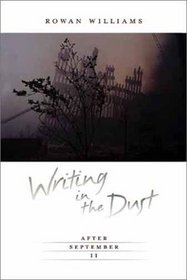 Writing in the Dust: After September 11 Rowan Williams (Eerdmans; 2002) $12.00 It is well known that a publisher can rush a book to press in nearly miraculous speed. When it is important, sometimes, this happens, and in the fall of 2001, there was a real need for a reliable and mature voice from within the mainstream Christian tradition addressing the horrible attack and the state of the world. There had been awful things said about the attack, and even those with well-grounded faith traditions felt confusion, grief, and anger (at the killers, of course, at Al Qaeda and militant Islam, at the politics of those years–each of us for our own reasons—and even at how some in the faith community hijacked the tragedy of the event seemingly for their own ignoble purposes.) I needn’t tell you that times were pretty awful and many looked to churches to offer words of insight and hope.
Writing in the Dust: After September 11 Rowan Williams (Eerdmans; 2002) $12.00 It is well known that a publisher can rush a book to press in nearly miraculous speed. When it is important, sometimes, this happens, and in the fall of 2001, there was a real need for a reliable and mature voice from within the mainstream Christian tradition addressing the horrible attack and the state of the world. There had been awful things said about the attack, and even those with well-grounded faith traditions felt confusion, grief, and anger (at the killers, of course, at Al Qaeda and militant Islam, at the politics of those years–each of us for our own reasons—and even at how some in the faith community hijacked the tragedy of the event seemingly for their own ignoble purposes.) I needn’t tell you that times were pretty awful and many looked to churches to offer words of insight and hope.
One of the early responses came from a deep and thoughtful pastoral letter, a handsome small book rushed to press by Eerdmans, an historic publisher in Grand Rapids, written from across the ocean. The author was the widely respected British Archbishop of Canterbury, a learned man and profound thinker, The Revered Rowan Williams. His ruminations came with a dust jacket with a subdued photo of an iconic bit of rubble, with a nearby tree, perhaps struggling for life. It had a simple quote on the front, naming it as a “fully sensitive theological contemplation” by Lutheran novelist, John Updike. On the back cover, Nicholas Woltersdorff, an extraordinary scholar and author of books on social justice and shalom, as well as one about personal loss and grief, says that Williams wrote about this particular grief “with hushed tones, as before a mystery.”
Writing in the Dust soon became an international best-seller, beloved by Episcopalians and Anglicans (it was endorsed by the Rector of the Parish of Trinity Church on Wall Street) but by others as well. Stanley Hauerwas noted that it was written with a “hard gentleness honed by the language of prayer.” The metaphor of dust, so poignant in the book, continues to haunt. It was an important, if occasionally uncomfortable, reflection, in the early days after the attack. I believe it is equally valuable today.
 Refractions: A Journey of Faith, Art and Culture Makoto Fujimura (NavPress) $24.99 Over the last twenty or so years Mako has worked hard at his abstract painting craft, has written and spoken widely about a Christian view of aesthetics, and has helped organize an extraordinary organization (IAM) which networks and supports artists and cultural creatives of all sorts. His 2009 break-out book was a collection of ruminations, pieces from his luminous blog, which he calls “refractions.” It is a book that (if you follow BookNotes) you know we routinely recommend. It is splendid! Mr. Fujimura works and worships in lower Manhattan and his children were in school within a few blocks of the WTC the morning of the attack, creating a panic for this gentle Christian family as the fateful day unfolded. His well-told reportage of that day is well worth reading. In fact, several chapters of this beautifully illustrated work tell of the way in which he and others organized artists in the neighborhood of Ground Zero to create visual and multi-media art installations that would offer (sacred?) space and give visual voice to grief. His clear insights about how the arts can be used to restore peace to a broken city are exceptionally profound and while this book isn’t exactly a 9-11 title, there are some chapters here that emerged from Mako’s work near Ground Zero in the years following the attack.
Refractions: A Journey of Faith, Art and Culture Makoto Fujimura (NavPress) $24.99 Over the last twenty or so years Mako has worked hard at his abstract painting craft, has written and spoken widely about a Christian view of aesthetics, and has helped organize an extraordinary organization (IAM) which networks and supports artists and cultural creatives of all sorts. His 2009 break-out book was a collection of ruminations, pieces from his luminous blog, which he calls “refractions.” It is a book that (if you follow BookNotes) you know we routinely recommend. It is splendid! Mr. Fujimura works and worships in lower Manhattan and his children were in school within a few blocks of the WTC the morning of the attack, creating a panic for this gentle Christian family as the fateful day unfolded. His well-told reportage of that day is well worth reading. In fact, several chapters of this beautifully illustrated work tell of the way in which he and others organized artists in the neighborhood of Ground Zero to create visual and multi-media art installations that would offer (sacred?) space and give visual voice to grief. His clear insights about how the arts can be used to restore peace to a broken city are exceptionally profound and while this book isn’t exactly a 9-11 title, there are some chapters here that emerged from Mako’s work near Ground Zero in the years following the attack.
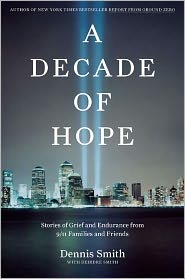 A Decade of Hope: Stories of Grief and Endurance From 9/11 Families and Friends Dennis Smith (Viking) $26.95 Everyone knows about the heroic bravery and self-sacrifice of so many first responders and fire fighters but few have followed their stories with the care and passion as Dennis Smith, whose Report From Ground Zero was the definitive account of those horrible first hours, certainly the most appreciated, well written, heart-stopping narrative of the rescue efforts. Written a few years after the attack it was a beautiful way to juxtapose those who died trying to save lives and the brutality of mass murder. Smith was a fire-fighter in New York and has been on the board of Tribute, the interim memorial at the World Trade Center. These new stories, based on years of diligent interviewing bring us important insight about how these families of rescue workers and victims have fared in the last decade, allowing their stories to put us in their shoes and finally give us a portrait of hope.
A Decade of Hope: Stories of Grief and Endurance From 9/11 Families and Friends Dennis Smith (Viking) $26.95 Everyone knows about the heroic bravery and self-sacrifice of so many first responders and fire fighters but few have followed their stories with the care and passion as Dennis Smith, whose Report From Ground Zero was the definitive account of those horrible first hours, certainly the most appreciated, well written, heart-stopping narrative of the rescue efforts. Written a few years after the attack it was a beautiful way to juxtapose those who died trying to save lives and the brutality of mass murder. Smith was a fire-fighter in New York and has been on the board of Tribute, the interim memorial at the World Trade Center. These new stories, based on years of diligent interviewing bring us important insight about how these families of rescue workers and victims have fared in the last decade, allowing their stories to put us in their shoes and finally give us a portrait of hope.
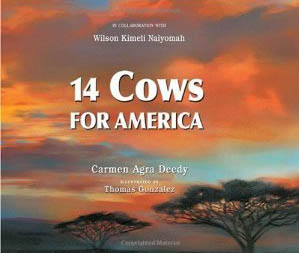 Cows for America Carmen Agra Deedy, illustrated by Thomas Gonzalez (Peachtree) $17.95 This may be one of the most stunning picture books in years—both the breath-taking art done by a Cuban illustrator and the sheer power of the story that is both sentimental and incredibly weighty. After the horrible bombings of 9-11, word got back to some Maasai tribesman in rural Kenya about this tragedy in the United States. (One of their young men had been studying in the states and was at United Nations students meeting and saw the towers fall.) They could hardly imagine (literally) what it meant to lose skyscrapers and that many lives, from a fireball that hot, but they understood that it was a large, large loss. Through a child’s idea, they wanted to help In their culture a cow is a sign of life, literally and mythically, and an elder tribesman was dispatched to find the American ambassador. The tribe wanted to give the United States people a cow. (This is unprecedented—they would seldom give such a prized possession to strangers.) A few more were donated by other poor Maasai warriors—again, these are their most prized possessions, and were offered as profound act of friendship to a grieving people. Can you imagine the ambassador wondering what to do with this beautiful gift of 14 bovine? When the story became known, Wilson Kimeli Naiyomah (the younger man in the tribe who was studying in the U.S. who first told the tribe the story of what he saw) was featured on Oprah, who helped fund his obtaining a science degree from Stanford, and was awarded a Rotary Club Peace Fellowship; he is soon to take up a degree in international peace studies. This art and text in this book is breath-takingly wonderful, capturing well the mood of this genous tale, and we highly, highly recommend it. It is an episode and a book that truly deserves to be widely, widely known.
Cows for America Carmen Agra Deedy, illustrated by Thomas Gonzalez (Peachtree) $17.95 This may be one of the most stunning picture books in years—both the breath-taking art done by a Cuban illustrator and the sheer power of the story that is both sentimental and incredibly weighty. After the horrible bombings of 9-11, word got back to some Maasai tribesman in rural Kenya about this tragedy in the United States. (One of their young men had been studying in the states and was at United Nations students meeting and saw the towers fall.) They could hardly imagine (literally) what it meant to lose skyscrapers and that many lives, from a fireball that hot, but they understood that it was a large, large loss. Through a child’s idea, they wanted to help In their culture a cow is a sign of life, literally and mythically, and an elder tribesman was dispatched to find the American ambassador. The tribe wanted to give the United States people a cow. (This is unprecedented—they would seldom give such a prized possession to strangers.) A few more were donated by other poor Maasai warriors—again, these are their most prized possessions, and were offered as profound act of friendship to a grieving people. Can you imagine the ambassador wondering what to do with this beautiful gift of 14 bovine? When the story became known, Wilson Kimeli Naiyomah (the younger man in the tribe who was studying in the U.S. who first told the tribe the story of what he saw) was featured on Oprah, who helped fund his obtaining a science degree from Stanford, and was awarded a Rotary Club Peace Fellowship; he is soon to take up a degree in international peace studies. This art and text in this book is breath-takingly wonderful, capturing well the mood of this genous tale, and we highly, highly recommend it. It is an episode and a book that truly deserves to be widely, widely known.
Here is a splendid little video that shows most of the art from the 14 Cows book. You will enjoy it, I’m sure, and hopefully will think of somebody you can share this with. Here is a 5 minute clip of the author, the delightful Carman Deedy, describing the story, the book, and what it meant to her to be involved in this poignant drama. There is a lot of very dramatic backstory here, so don’t miss it. Then buy the book—please!
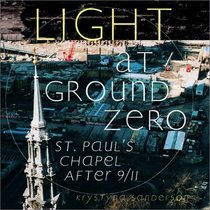 Light at Ground Zero: St. Paul’s Chapel After 9/11 Krystyna Sanderson (Square Halo Press) $15.99 At the very heart of the hell that was Ground Zero on the day of September 11, 2001, and the hard months following, stands St. Paul’s Episcopal Church, just yards away from the destroyed Building 5 of the World Trade Center. Hurrying from her home in Greenwich Village, photographer Krystyna Sanderson headed to lower Manhattan amidst the smoke and dust to help with rescue efforts. In the first paragraph of the introduction to this collection of photographs–a piece which still causes me to choke up, even though I’ve read it numerous times–she tells of how amazed she was that her church was not destroyed. “Except for a layer of ash and soot, the building survived unscathed. Many proclaimed that ‘St. Paul’s had been spared.’ It seemed clear to me that if this was true, it was not because we were holier than anyone who died across the street; it was because we now had a big job to do.”
Light at Ground Zero: St. Paul’s Chapel After 9/11 Krystyna Sanderson (Square Halo Press) $15.99 At the very heart of the hell that was Ground Zero on the day of September 11, 2001, and the hard months following, stands St. Paul’s Episcopal Church, just yards away from the destroyed Building 5 of the World Trade Center. Hurrying from her home in Greenwich Village, photographer Krystyna Sanderson headed to lower Manhattan amidst the smoke and dust to help with rescue efforts. In the first paragraph of the introduction to this collection of photographs–a piece which still causes me to choke up, even though I’ve read it numerous times–she tells of how amazed she was that her church was not destroyed. “Except for a layer of ash and soot, the building survived unscathed. Many proclaimed that ‘St. Paul’s had been spared.’ It seemed clear to me that if this was true, it was not because we were holier than anyone who died across the street; it was because we now had a big job to do.”
Any rescue effort at huge global disasters will always be full of drama and passion, pain and tears and the very best and worst of human endeavor. St. Paul’s became a center of all this, a weigh-station for the rescue teams, a hang-out for the first responders, a place of rest and recovery from those involved in one of the most intense human ministries in recent memory. Day by day the brave rescue workers and helpers and chaplains dug through the rubble and day by day Ms Sanderson documented on film with her expert eye and artistry the ministry of the chapel. This paperback book is har
dly a coffee table book: it is too precious for that, and its relatively small size makes it perfect for prayerful consideration.
These shots are tragic, of course, but yet triumphant. To see the church altar covered with the heavy rubber coats of the workers, to see the styrofoam coffee cups by the knave, to see the pews turned into first aid stations, to see the hand-made emergency signage taped over the stained glass, is to glimpse a vision of the church made messy in ministry to the world. Anyone who cares about the nature of the church’s work will glimpse a parable here; more than a parable, a reality. The radical hospitality offered as relief workers partnered with folks of good will from around the world is shown visibly in these lavish full-color photographs. The photos could easily stand alone, and on many pages they do, but there is a brief and tasteful illumination by setting alongside them text from the Episcopal Book of Common Prayer. Thank goodness this work, too, came to press in the year immediately following 9-11. Thank goodness it remains not only as a close-up remembrance of this ministry among the horror, but an on-going reminder, a photo essay, of the goodness of human kindness and the resilience of those dedicated to life-giving service.
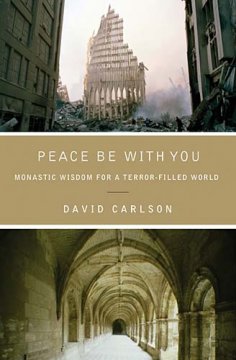 Peace Be With You: Monastic Wisdom for a Terror-Filled World David Carlson (Nelson) $15.99 Of the several books I’ve pondered this month around this theme this one stands out. It is based on a fabulous idea, rooted in a fabulous question: do monks and nuns have anything to say to us about how to think about the horror of 9-11 and how to respond in these times? This new book was envisioned, it seems, nearly a decade ago when the author, a Baptist college professor who had converted to Orthodoxy, longed for greater clarity about his own unsettled spirit after the attacks of 9-11. The handsome cover art of this paperback tells us of his journey: there is a stark picture of Ground Zero rubble on the top half of the cover design, while the lower half of the cover is a stunning photo of the walkway of a historic old abbey. Indeed, the question of Professor Carlson is about the relationship of the two: what insight might monks and nuns, sequestered at their monasteries, have on how we remember–and respond to, even now–the terrors of that day?
Peace Be With You: Monastic Wisdom for a Terror-Filled World David Carlson (Nelson) $15.99 Of the several books I’ve pondered this month around this theme this one stands out. It is based on a fabulous idea, rooted in a fabulous question: do monks and nuns have anything to say to us about how to think about the horror of 9-11 and how to respond in these times? This new book was envisioned, it seems, nearly a decade ago when the author, a Baptist college professor who had converted to Orthodoxy, longed for greater clarity about his own unsettled spirit after the attacks of 9-11. The handsome cover art of this paperback tells us of his journey: there is a stark picture of Ground Zero rubble on the top half of the cover design, while the lower half of the cover is a stunning photo of the walkway of a historic old abbey. Indeed, the question of Professor Carlson is about the relationship of the two: what insight might monks and nuns, sequestered at their monasteries, have on how we remember–and respond to, even now–the terrors of that day?
The idea of the book is simple and, despite the weighty topic, a bit light-hearted: the author goes on a road trip (sometimes accompanied by his non-believing adult son) to a handful of far-away and secluded monasteries, obtaining interviews with the often reluctant monks. How did they remember the news? How did they feel about it? Did their schooling in the ways of prayer equip them to respond more peacefully, with more Godly focus or wisdom? What insights, since then, have they developed, based on their spiritual disciplines and global brother or sisterhoods, that might be offered to a world such as ours?

 The book is truly interesting, as books that include memoir and travelogue can be; it is even a bit clever at times. The author is self-aware and realizes a good adventure when he sees one.
Some of these intentional communities are deep in the canyons of New Mexico or across miles of harsh terrain and he writes about them well. For instance, after a grueling trip along some treacherously icy canyon-lands–well, these roads are treacherous even without the ice, it seems— he celebrates worship with Russian monks at their skete standing for two hours in the snow (their pipes have frozen so they can’t use the indoor chapel.) The book is not just travel writing, but it is enjoyable, including the portions where he is visiting more urban monastic communities. He talks about his journey, his relationship with his adult son, the anxiety he has about ever completing this rather off-beat project (some monks, as you can imagine, would rather do almost anything than talk!) And, yet, he finds some real characters,too. (Do you know the story of Thomas Merton laughing about smelly feet? Persons committed to a monastic lifestyle are still themselves, he finds, and, yes, he does go to the famous Merton location in Kentucky. How could he not?)
So the idea is easy: find some people who were praying the day of the attack, and find out if their prayer habits made a difference about how they felt about the attack during and afterwards.
But it is not really so a simple quest as it ends up. Carlson admits to his own inner demons, he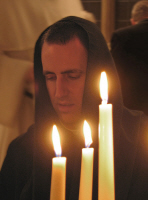 struggles with bouts of depression and carries great remorse about the mean-spiritedness of much of our political discourse (especially regarding our relationship with Islam.) Surely, he thinks, these men and women whose vocation is to pray and who know silence, who worship often and serve humbly, have nurtured habits of heart that will allow them to speak well into our needy times. He is both grateful for such good insights and happy to report much of the Christ-like character these prayerful saints exhibit. Hearing their take on international affairs, and the soul of our nation, is powerful. But, as we all should surely know, monks and nuns are not in a holy bubble; they have internet and watch the news, and often live lively lives engaged in local neighborhoods. (I enjoyed one chapter where Carlson was spending time in a monastery whose urban mission included a bread baking business and cafe. Working with the general public isn’t the most “devotional” space for cultivating deep mystery, often, yet these men used their daily frustrations to guide them to greater Christ-likeness. Men and women called to these religious vows are human, and struggle with the same quandaries of discipleship we all do when it comes to questions of forgiveness, mercy, peace and justice, caring about our daily issues and wanting to be aware of global concerns.
struggles with bouts of depression and carries great remorse about the mean-spiritedness of much of our political discourse (especially regarding our relationship with Islam.) Surely, he thinks, these men and women whose vocation is to pray and who know silence, who worship often and serve humbly, have nurtured habits of heart that will allow them to speak well into our needy times. He is both grateful for such good insights and happy to report much of the Christ-like character these prayerful saints exhibit. Hearing their take on international affairs, and the soul of our nation, is powerful. But, as we all should surely know, monks and nuns are not in a holy bubble; they have internet and watch the news, and often live lively lives engaged in local neighborhoods. (I enjoyed one chapter where Carlson was spending time in a monastery whose urban mission included a bread baking business and cafe. Working with the general public isn’t the most “devotional” space for cultivating deep mystery, often, yet these men used their daily frustrations to guide them to greater Christ-likeness. Men and women called to these religious vows are human, and struggle with the same quandaries of discipleship we all do when it comes to questions of forgiveness, mercy, peace and justice, caring about our daily issues and wanting to be aware of global concerns.
Peace Be With You takes us into this mix of sinners and saints on a holy road trip, leaving us with very big questions and some very significant answers. I think this would make a perfect book club book—even if your group isn’t used to reading overtly religious books. This story is so interesting, the writing so clear, and the question so significant that it deserves to be read and pondered. What do you think, does having a deep and consistent prayerfulness, nurtured in practices of solitude and silence, make you a better citizen, a more Christ-like peacemaker, a person with something to say about 9-11? Read this book for yourself; it’s a winner!
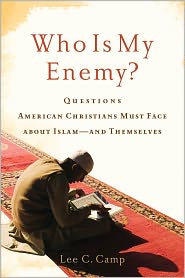 Who Is My Enemy? Questions American Christians Must Face About Islam—and Themselves Lee C. Camp (Brazos) $17.99 I will be doing a larger more substantive review, Lord willing, of this remarkable brand new book but I simply had to list it now. It may be one of the most interesting and informative and important books of the whole year (and I mean that!) Camp is known for at least two things. First he developed a bit of a following when he released a very powerful and exceptionally well-reviewed overview of serious Christian discipleship called Mere Discipleship: Radical Christianity in a Rebellious World (2nd edition) (Brazos; $21.99)&nbs
Who Is My Enemy? Questions American Christians Must Face About Islam—and Themselves Lee C. Camp (Brazos) $17.99 I will be doing a larger more substantive review, Lord willing, of this remarkable brand new book but I simply had to list it now. It may be one of the most interesting and informative and important books of the whole year (and I mean that!) Camp is known for at least two things. First he developed a bit of a following when he released a very powerful and exceptionally well-reviewed overview of serious Christian discipleship called Mere Discipleship: Radical Christianity in a Rebellious World (2nd edition) (Brazos; $21.99)&nbs
p; It is a more serious and mature study for those who like Bonheffer’s Cost of Discipleship, say, or the punchy writings of Hauerwas or Yoder, Walter Wink or William Stringfellow. Endorsements include rave blurbs from missional dudes Frost and Hersch. If you’ve read, say, Crazy Love or Radical, you need to advance to this.
Secondly, Camp got deluged with vulgar hate mail when a Nashville newspaper misquoted him (inadvertently, he graciously believes) as saying that Christians must “let go” of some of their theological claims in order to get along with Muslims. Of course this is ridiculous, no evangelical leader involved in serious interfaith dialogue would say such a thing (you can read his clarification, here.) But few gave him the benefit of the doubt and he was severely rebuked by people from all over the world within a day’s time. Many called for him to be fired from the college at which he taught. A few were legitimately concerned about a Christian leader suggesting doctrinal compromise but many more were incredulous about any desire to work for conflict resolution with Muslims. So, Camp was quickly exposed to deep and troubling hostility by people claiming to be Christians. He’s aware of the firmness of many anti-Muslim Christian activists, how some are very quick to hint at violence, and how anger and fear are often just below the surface of any conversations about how we are to perceive Islamic neighbors. I’ve experienced some of that unreasonable hostility myself and cant imagine how he felt getting such scary emails and phone calls, people writing inaccurately about him.
Well, in this wide-ranging work, Camp tells some of his story of what he had to do in response to that firestorm. He felt that he had to study more and come to know Muslims personally. He draws on some significant insights of Miroslov Volf, reads widely, and takes off. He attends programs at the local mosque, travels to several important sites—from the Blue Mosque in Istanbul to the Oklahoma City National Memorial to Hebron in Palestine to the Old City of Jerusalem and to a local Arab barbershop. He gets to know some ordinary Muslims and some devout Muslim scholars.
As you may guess, Camp is mostly interested in the question of violence and war. Are they out to get us? How do Muslim leaders understand the limits to war? Is there a restraining sort of just war theory in Islamic thinking as there is in the West? What about Bin Laden? And—and this is where it speaks truthfully, painfully, and will, sadly, be controversial (get ready for more hate mail, Lee)–how do those who have grossly violated the just war theory in our own history have any moral high ground to critique jihadi violence? What might it mean to take a log out of our own eye even as we rebuke and resist others? Camp is clear to state that this isn’t a typical argument about “moral equivalency” and he offers much nuance in his teaching, whether it is about Puritan violence against Native Americans or the evil done during the Crusades. He does serious Bible study and explores that thorny ground of hermeneutics (that is, how do Muslims interpret their Scriptures and how do Christians interpret theirs, especially on the legitimizing of violence?) Camp invites us all to explore the way that Christ calls us to be peacemakers and wonders how to do that in light of the realities of the Islamic story and the facts of the Christian story.
I will have much more to say about this new angle on “Christian-Muslim” dialogue but wanted you to know we have it in stock now, I’ve read it all, and am very, very confident that regardless of your level of awareness about Islamic teachings or history or where you stand on the ethics of war, in this month after the anniversary of 9-11 we will simply have to have something better to say than the modernist liberal assumption that religion is mostly part of the problem or the right wing ugliness that burns Qu’rans and wants a holy crusade against an axis of evil. Camp gives us a better way to think about the clash of civilizations and Who is My Enemy? will be of interest to anyone who cares about the state of the world in this era of terrorism. Glen Stassen has said it is “truly the best book I know for all Christians who want to be faithful to Jesus while figuring out how to relate to Islam.” Scott McKnight calls the author “courageous.” Highly recommended.
DISCOUNT
– any book mentioned –
20% off
order here
takes you to the secure Hearts & Minds order form page
inquire here
if you have questions or need more information
